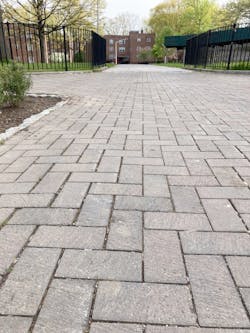Michael Moscariello, PE, LEED AP, PMP, is national green infrastructure practice lead for Arcadis. Moscariello can be reached at [email protected].
As flooding events around the world grow more intense and frequent, communities looking to better manage their water resources are exploring new avenues of implementing porous pavement. Porous pavement is a type of green infrastructure that replaces conventional pavements allowing storm water to flow through the surface to the underlying storage layer and ultimately infiltrates to the soil. Common types include porous concrete, porous asphalt and permeable pavers. As with any public infrastructure implementation, looking at porous pavement as one element of an integrated or “complete streets” program is critical to its success.
Like other green infrastructure, porous pavement helps restore some of nature’s historic water capture and treatment capabilities to neighborhoods’ parking, walkways, driveways, trails and streets. It reduces storm water runoff, in turn potentially reducing flooding, the concentration of pollutants in runoff and even the temperature of the runoff. Ecologically, porous pavement is an attractive investment. To fully reap the benefits of the installation, however, every step in the process, from planning to design to ongoing maintenance, must be approached holistically.
Prioritization & Planning for Porous Pavement Success
When considering the benefits of porous pavement in a neighborhood or on a street, you must start by evaluating the needs of the local environment and community. Understanding these needs in the earliest stages of planning will help ensure impactful outcomes and will facilitate prioritization of green infrastructure.
Consider the scope of work and whether it is an individual site-based project looking to implement sustainable solutions or if it is part of a larger city-wide program intended to improve storm water quality and reduce runoff to streams and rivers. Understand the peripheral impacts and plan accordingly. Existing storm water management methods, existing infrastructure, trees and natural features or other site factors and limitations may be in place that will not allow for reasonable design implementation. Ignoring those potential impacts and runoff interactions could harm project success. While porous pavement may not always be the best solution in every application, using planning strategies as guidance can help teams realize porous pavement is a viable alternative for implementation within a comprehensive green infrastructure program.
Often, integrating green infrastructure solutions in public spaces presents challenges from a funding, construction and maintenance standpoint. It is important to establish these responsibilities at the earliest stage of a project and structure the implementation accordingly. Siloed funding, or funding from different city departments, can affect how green infrastructure budgets are allocated for design, implementation and ongoing maintenance. For example, a city’s department of transportation or department of sanitation might handle street cleaning, which is critical for porous pavement maintenance, but design and installation might reside with a storm water or resiliency department. Similarly, there is also a relationship between the departments responsible for paving and curbs, and the municipal water or storm water departments responsible for installing and maintaining inlets and conveyance systems. Looking at the full scope of what implementation and upkeep means for your city is critical to ensuring that porous pavement is the best solution.
Finally, climate is a critical aspect of any storm water infrastructure decision and must be factored in during the earliest stages of a project. Frequent salting and sanding in winter, for example, can counteract the pavement’s porous nature and prevent storm water from flowing through as planned. Alternatively, porous pavement might be advantageous for municipalities that are not as susceptible to inclement winter weather and subsequent maintenance activities. Lower traffic streets or alleys that are not primary salting and sanding targets can also be good locations for porous pavement. Use your assessment phase to determine whether site or community conditions will allow you to realize all of porous pavement’s environmental and financial benefits.
Porous Pavement in Application
Much like the assessment, the porous pavement design phase should take a comprehensive, holistic approach. This means determining the best location, layout and scale for each system but also learning from and improving upon design best practices set in place.
Hydraulic and pollutant loading is one example of this. While there are industry standards for porous pavement and loading factors, keeping a critical eye on those ratios together with site variables like pollutant sources, topography, seasonal impacts, maintenance approach and more can paint a detailed picture. Smaller distributed linear porous pavement practices, as opposed to central concentrated layouts, can also help overcome loading challenges.
If more frequent maintenance is available, then the design of the installation does not need to be as restrictive with loading factors as it might be in a location with less frequent cleanings. Beyond any one city or operator, it is also the responsibility of the storm water industry in general to provide best practices as they apply to designing and maintaining porous pavement and other green infrastructure installations. If greater water capture, reuse or even just improving runoff quality and reducing treatment costs can happen more easily with more robust maintenance programs, the industry should reconsider recommendations for when and how best to implement any green infrastructure practice.
As compared to other green infrastructure, porous pavement can take on many shapes and integrate easily into various applications, typically without impacting other programing functions. For example, most city blocks with street parking can incorporate a narrow strip of porous pavement along the length of a parking lane to manage storm water from the street. Urban areas across the country, including New York City and Washington D.C. have implemented porous pavement in this capacity. Other green infrastructure solutions along city blocks would likely require eliminating a few parking spaces to manage the same drainage areas. Considering porous pavement and its vast applications opens up a number of new opportunities in areas green infrastructure may not have been considered for or seemed feasible.
When looking at a community or street’s combined needs, keep in mind that when implemented properly, sustainable measures like green infrastructure help beautify communities, in turn driving economic development and opportunity. However, compared to other green infrastructure practices like bioswales, rain gardens and urban forests, porous pavement’s aesthetic benefit resides in the surrounding environment rather than the installation itself. Whether it reduces contaminated runoff that contributes to algae blooms or promotes healthy plant growth through better storm water distribution, the environmental benefit of porous pavement goes far beyond any one parking lot or street.
Maintaining Green Infrastructure
Admittedly, porous pavement can be expensive to implement initially and requires ongoing maintenance to remain impactful. However, in many cases the necessary maintenance methods are relatively easy to implement as compared to other green infrastructure techniques; it simply needs to be accounted for appropriately in the early stages of implementation.
Eighty percent of the U.S. population lives in a municipality that has an MS4 program. Many municipalities with an MS4 are required to either street sweep or street sweep as part of their beautification plans. As such, with some modifications, porous pavement might be a natural fit for some communities. In Richmond, Virginia, porous pavement is under evaluation because the city is already deploying trained crews with vacuum trucks, meaning this green infrastructure solution is entirely within reach from a maintenance perspective. In D.C., Arcadis’ storm water and data analytics experts worked with the public works department to optimize its existing street sweeping programs, benefitting any existing or future porous pavement installation and the District’s bottom line. As is reflected in the Biden administration’s American Jobs Plan, looking at how infrastructure connects to other operations can be an avenue for more sustainable cities and can also drive cross-departmental cost savings and even job creation, if approached holistically.
As with any form of infrastructure or public service, regulatory compliance is critical throughout the full lifecycle of a project. Cleaner streets and cleaner water are always an attractive outcome, but regulatory frameworks do not always account for the interconnected nature of green infrastructure solutions like porous pavement. In these instances, looking at regulatory standards with an eye for the economic development that comes with beautifying a city and making it more sustainable can ensure better long-term outcomes.
Ultimately, porous pavement is a strong green infrastructure candidate for any sustainability or storm water management initiative. However, taking a step back to look at the big picture of how it can work best for all of a community’s environmental and economic needs will result in a more resilient and impactful implementation.






